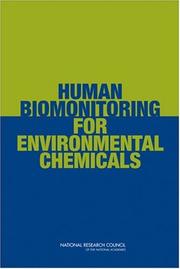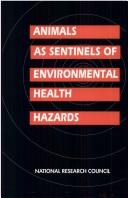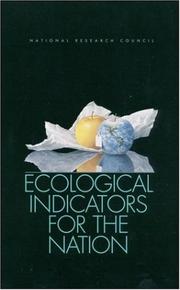| Listing 1 - 10 of 32 | << page >> |
Sort by
|
Book
ISBN: 012812055X 0128120266 9780128120552 9780128120262 178785924X Year: 2020 Publisher: London, England : Academic Press,
Abstract | Keywords | Export | Availability | Bookmark
 Loading...
Loading...Choose an application
- Reference Manager
- EndNote
- RefWorks (Direct export to RefWorks)
Handbook on Biological Warfare Preparedness provides detailed information on biological warfare agents and their mode of transmission and spread. In addition, it explains methods of detection and medical countermeasures, including vaccine and post-exposure therapeutics, with specific sections detailing diseases, their transmission, clinical signs and symptoms, diagnosis, treatment, vaccines, prevention and management. This book is useful reading for researchers and advanced students in toxicology, but it will also prove helpful for medical students, civil administration, medical doctors, first responders and security forces.
Biological monitoring. --- Biological Warfare. --- Biologic monitoring --- Biomonitoring (Toxicology) --- Monitoring, Biological --- Poisons --- Toxicology --- Indicators (Biology) --- Analysis --- Biologic Warfare --- Warfare, Bacterial --- Warfare, Biological --- Bacterial Warfare --- Warfare, Biologic --- Violence --- Bioterrorism --- Civil defense readiness --- Biological monitoring --- Biological disasters --- Biological warfare --- Biosecurity --- Emergency management. --- Prevention

ISBN: 1280704888 9786610704880 0309663156 9780309663151 0309102723 9780309102728 0309133904 Year: 2006 Publisher: Washington, D.C. : National Academies Press,
Abstract | Keywords | Export | Availability | Bookmark
 Loading...
Loading...Choose an application
- Reference Manager
- EndNote
- RefWorks (Direct export to RefWorks)
Biological monitoring. --- Environmental monitoring. --- Toxicity testing. --- Toxicology. --- Chemicals --- Medicine --- Pharmacology --- Poisoning --- Poisons --- Toxicological testing --- Toxicology --- Toxicology testing --- Toxicology, Experimental --- Biomonitoring (Ecology) --- Ecological monitoring --- Environmental quality --- Monitoring, Environmental --- Applied ecology --- Environmental engineering --- Pollution --- Biologic monitoring --- Biomonitoring (Toxicology) --- Monitoring, Biological --- Indicators (Biology) --- Testing --- Measurement --- Monitoring --- Analysis --- Biological monitoring --- Environmental monitoring --- Toxicity testing
Book
ISBN: 1283155265 9786613155269 0643097139 9780643097131 9780643099432 0643099433 9780643090583 0643090584 9781283155267 Year: 2009 Publisher: Collingwood, Vic. : CSIRO Pub.,
Abstract | Keywords | Export | Availability | Bookmark
 Loading...
Loading...Choose an application
- Reference Manager
- EndNote
- RefWorks (Direct export to RefWorks)
A comprehensive introduction to the biology and ecology of plankton.
Plankton --- Indicators (Biology) --- Bioindicators --- Biological environmental indicators --- Biological indicators --- Ecological indicators --- Environmental indicators, Biological --- Sentinel organisms --- Ecology --- Biological monitoring --- Biological reagents --- Water quality biological assessment --- Plankton sampling --- Aquatic biology --- Ecology. --- Measurement.
Book
ISBN: 1486308805 9781486308804 9781486308798 1486308791 9781486308811 1486308813 9780367030162 0367030160 Year: 2019 Publisher: Clayton South, VIC : CSIRO Publishing,
Abstract | Keywords | Export | Availability | Bookmark
 Loading...
Loading...Choose an application
- Reference Manager
- EndNote
- RefWorks (Direct export to RefWorks)
Healthy waterways and oceans are essential for our increasingly urbanised world. Yet monitoring water quality in aquatic environments is a challenge, as it varies from hour to hour due to stormwater and currents. Being at the base of the aquatic food web and present in huge numbers, plankton are strongly influenced by changes in environment and provide an indication of water quality integrated over days and weeks. Plankton are the aquatic version of a canary in a coal mine. They are also vital for our existence, providing not only food for fish, seabirds, seals and sharks, but producing oxygen, cycling nutrients, processing pollutants, and removing carbon dioxide from our atmosphere. This Second Edition is a fully updated introduction to the biology, ecology and identification of plankton and their use in monitoring water quality. It includes expanded, illustrated descriptions of all major groups of freshwater, coastal and marine phytoplankton and zooplankton and a new chapter on teaching science using plankton. Best practice methods for plankton sampling and monitoring programs are presented using case studies, along with explanations of how to analyse and interpret sampling data. The book is an invaluable reference for teachers and students, environmental managers, ecologists, estuary and catchment management committees, and coastal engineers
Plankton --- Indicators (Biology) --- Bioindicators --- Biological environmental indicators --- Biological indicators --- Ecological indicators --- Environmental indicators, Biological --- Sentinel organisms --- Ecology --- Biological monitoring --- Biological reagents --- Water quality biological assessment --- Aquatic biology --- Ecology. --- Water quality --- Measurement --- Plankton - Ecology --- Plankton - Measurement --- Water quality - Measurement

ISBN: 0309040469 9786610214365 1280214368 0309594898 0585085269 9780585085265 9780309040464 Year: 1991 Publisher: Washington, D.C. : National Academy Press,
Abstract | Keywords | Export | Availability | Bookmark
 Loading...
Loading...Choose an application
- Reference Manager
- EndNote
- RefWorks (Direct export to RefWorks)
Assessment [Health risk ] --- Biological monitoring --- Biologisch elektronisch toezicht --- Estimation des risques de santé --- Gezondheid [Schatting van het risico voor de ] --- Gezondheidsrisico [Schatting van het ] --- HRA (Public health) --- Health hazard appraisal --- Health hazard assessment --- Health risk appraisal --- Health risk assessment --- Human risk assessment --- Monitoring [Biological ] --- Risico voor de gezondheid [Schatting van het ] --- Schatting van het risico voor de gezondheid --- Surveillance électronique biologique --- Biological monitoring. --- Health risk assessment. --- Toxicology --- Animal models. --- Assessment, Health risk --- Biologic monitoring --- Biomonitoring (Toxicology) --- Monitoring, Biological --- Medicine, Preventive --- Public health --- Risk assessment --- Environmental health --- Poisons --- Indicators (Biology) --- Animal models in research --- Toxicology, Experimental --- Alternative toxicity testing --- Analysis --- Animal models --- Toxicology - Animal models.
Book
ISBN: 1280596147 9786613625977 0123854687 0123854679 9780123854681 9780123854674 Year: 2012 Publisher: Amsterdam : Elsevier/Academic Press,
Abstract | Keywords | Export | Availability | Bookmark
 Loading...
Loading...Choose an application
- Reference Manager
- EndNote
- RefWorks (Direct export to RefWorks)
Therapeutic Drug Monitoring: Newer Drugs and Biomarkers features timely topics such as the monitoring of classical and newer drugs, pharmacogenomics and the application of biomarkers in therapeutic drug monitoring. This reference also discusses the limitations of current commercially available immunoassays for therapeutic monitoring. It presents new and sophisticated techniques used for proper determination of blood levels and the clinical utility of therapeutic drug monitoring of contemporary drugs. Written by leading international experts and geared toward clinical pathologists, to
Biochemical markers. --- Biological monitoring. --- Drug monitoring. --- Drugs -- Analysis. --- Pharmacokinetics. --- Drug monitoring --- Genetics --- Pharmacology --- Monitoring, Physiologic --- Biological Science Disciplines --- Diagnostic Techniques and Procedures --- Biology --- Health Occupations --- Diagnosis --- Disciplines and Occupations --- Natural Science Disciplines --- Analytical, Diagnostic and Therapeutic Techniques and Equipment --- Drug Monitoring --- Pharmacogenetics --- Health & Biological Sciences --- Pharmacy, Therapeutics, & Pharmacology --- Drugs --- Monitoring, Drug --- Therapeutic drug monitoring --- Patient monitoring --- Monitoring --- Analysis --- Testing


ISBN: 0309068452 0585256373 0309515548 9780585256375 9780309068451 0305068452 0309172470 Year: 2000 Publisher: Washington, D.C. : National Academy Press,
Abstract | Keywords | Export | Availability | Bookmark
 Loading...
Loading...Choose an application
- Reference Manager
- EndNote
- RefWorks (Direct export to RefWorks)
Environmental indicators, such as global temperatures and pollutant concentrations, attract scientists' attention and often make the headlines. Equally important to policymaking are indicators of the ecological processes and conditions that yield food, fiber, building materials and ecological "services" such as water purification and recreation.This book identifies ecological indicators that can support U.S. policymaking and also be adapted to decisions at the regional and local levels. The committee describes indicators of land cover and productivity, species diversity, and other key ecological processes--explaining why each indicator is useful, what models support the indicator, what the measured values will mean, how the relevant data are gathered, how data collection might be improved, and what effects emerging technologies are likely to have on the measurements. The committee reviews how it arrived at its recommendations and explores how the indicators can contribute to policymaking. Also included are interesting details on paleoecology, satellite imagery, species diversity, and other aspects of ecological assessment. Federal, state, and local decisionmakers, as well as environmental scientists and practitioners, will be especially interested in this new book.
Environmental monitoring. --- Indicators (Biology) --- Environmental Sciences and Forestry. Ecology --- Ecology (General) --- Indicators (Biology). --- Ecology (General). --- Biomonitoring (Ecology) --- Ecological monitoring --- Environmental quality --- Monitoring, Environmental --- Bioindicators --- Biological environmental indicators --- Biological indicators --- Ecological indicators --- Environmental indicators, Biological --- Sentinel organisms --- Measurement --- Monitoring --- Applied ecology --- Environmental engineering --- Pollution --- Ecology --- Biological monitoring --- Biological reagents --- Water quality biological assessment --- Environmental Monitoring --- Science
Book
ISBN: 1281072354 9786611072353 0080527973 9781281072351 9780080527970 Year: 2007 Publisher: [Ottawa] Agriculture and Agri-Food Canada
Abstract | Keywords | Export | Availability | Bookmark
 Loading...
Loading...Choose an application
- Reference Manager
- EndNote
- RefWorks (Direct export to RefWorks)
This book provides comprehensive single source coverage of bioindication/biomonitoring in the fields of ecology, ecotoxicology and environmental sciences; from the ecological basics to the effects of chemicals on the environment and the latest test strategies. Contributions by leading figures in ecology from around the world reflect the broad scope of current thinking and research, making this volume essential reading for informed professionals and students.
Indicators (Biology) --- Environmental monitoring. --- Biomonitoring (Ecology) --- Ecological monitoring --- Environmental quality --- Monitoring, Environmental --- Applied ecology --- Environmental engineering --- Pollution --- Bioindicators --- Biological environmental indicators --- Biological indicators --- Ecological indicators --- Environmental indicators, Biological --- Sentinel organisms --- Ecology --- Biological monitoring --- Biological reagents --- Water quality biological assessment --- Measurement --- Monitoring
Book
ISBN: 9780521514002 9781139206068 1139206060 1139031791 9781139031790 0521514002 9781139203074 9781139199452 1139199455 1107224152 9781107224155 1280484314 9781280484315 9786613579294 6613579297 1139205269 9781139205269 113920307X 9781139203074 1139201662 9781139201667 1139204483 9781139204484 Year: 2012 Publisher: Cambridge, UK ; New York : Cambridge University Press,
Abstract | Keywords | Export | Availability | Bookmark
 Loading...
Loading...Choose an application
- Reference Manager
- EndNote
- RefWorks (Direct export to RefWorks)
Integrating research into freshwater biodiversity and the role of keystone species, this fascinating book presents freshwater crayfish as representatives of human-exacerbated threats to biodiversity and conservation. It uses examples from these and other large decapod invertebrates to explore how communities function and are controlled, alongside the implications of human demands and conflicts over limited resources, notably the severe impacts on biodiversity. The discussion is structured around three key topics - the present situation of crayfish in world freshwater ecosystems, the applications of science to conservation management and knowledge transfer for successful crayfish management. It outlines the historic exploitation of crayfish, addressing the problems caused by invasive alien forms and explaining the importance of correct identification when dealing with conservation issues. Offering a global perspective on freshwater systems, the book ultimately highlights how the conservation of such large and long-lived species will help protect ecosystem quality in the future.
Crayfish --- Freshwater biodiversity conservation. --- Indicators (Biology) --- Ecology. --- Bioindicators --- Biological environmental indicators --- Biological indicators --- Ecological indicators --- Environmental indicators, Biological --- Sentinel organisms --- Ecology --- Biological monitoring --- Biological reagents --- Water quality biological assessment --- Conservation of freshwater biodiversity --- Freshwater biodiversity --- Freshwater biological diversity conservation --- Aquatic biodiversity conservation --- Crawdaddies --- Crawdads --- Crawfish --- Crawfishes --- Crayfishes --- Decapoda (Crustacea) --- Astacology --- Conservation
Book
ISBN: 9289343346 9289343338 9789289343336 9789289343329 Year: 2015 Publisher: Copenhagen, [Denmark] : Nordic Council of Ministers,
Abstract | Keywords | Export | Availability | Bookmark
 Loading...
Loading...Choose an application
- Reference Manager
- EndNote
- RefWorks (Direct export to RefWorks)
Biological monitoring --- Environmental monitoring --- Environmental health --- Environmental quality --- Health --- Health ecology --- Public health --- Environmental engineering --- Health risk assessment --- Biomonitoring (Ecology) --- Ecological monitoring --- Monitoring, Environmental --- Applied ecology --- Pollution --- Biologic monitoring --- Biomonitoring (Toxicology) --- Monitoring, Biological --- Poisons --- Toxicology --- Indicators (Biology) --- Government policy. --- Health aspects --- Environmental aspects --- Measurement --- Monitoring --- Analysis
| Listing 1 - 10 of 32 | << page >> |
Sort by
|

 Search
Search Feedback
Feedback About UniCat
About UniCat  Help
Help News
News